Coburn J.W. Algebra and Trigonometry
Подождите немного. Документ загружается.


960 CHAPTER 10 Analytic Geometry and the Conic Sections 10-42
College Algebra & Trignometry—
CONCEPTS AND VOCABULARY
Fill in the blank with the appropriate word or phrase.
Carefully reread the section if needed.
1. The equation is that of a(n)
parabola, opening to the if
and to the left if .
2. If point P is on the graph of a parabola with
directrix D, the distance from P to line D is equal
to the distance between P and the of the
parabola.
3. Given the focus is at and the
equation of the directrix is .
y
2
4px,
a 7 0
x ay
2
by c
DEVELOPING YOUR SKILLS
Find the x- and y-intercepts (if they exist) and the
vertex of the parabola. Then sketch the graph by using
symmetry and a few additional points or completing the
square and shifting a parent function. Scale the axes as
needed to comfortably fit the graph and state the
domain and range.
7. 8.
9. 10.
11. 12.
Find the x- and y-intercepts (if they exist) and the vertex
of the graph. Then sketch the graph using symmetry
and a few additional points (scale the axes as needed).
Finally, state the domain and range of the relation.
13. 14.
15. 16.
17. 18.
Sketch using symmetry and shifts of a basic function. Be
sure to find the x- and y-intercepts (if they exist) and the
vertex of the graph, then state the domain and range of
the relation.
19. 20.
21. 22.
23. 24.
25. 26. x y
2
4y 5x y
2
y 6
x y
2
4y 4x y
2
2y 1
x y
2
9x y
2
4
x y
2
8yx y
2
6y
x y
2
6y 9x y
2
8y 16
x y
2
8y 12x y
2
6y 7
x y
2
4y 12x y
2
2y 3
y 2x
2
7x 3y 2x
2
5x 7
y 3x
2
12x 15y 2x
2
8x 10
y x
2
6x 5y x
2
2x 3
27. 28.
29. 30.
31. 32.
33. 34.
35. 36.
Find the vertex, focus, and directrix for the parabolas
defined by the equations given, then use this information
to sketch a complete graph (illustrate and name these
features). For Exercises 43 to 60, also include the focal
chord.
37. 38.
39. 40.
41. 42.
43. 44.
45. 46.
47. 48.
49.
50.
51.
52.
53.
54. 2x
2
8x 16y 24 0
3x
2
24x 12y 12 0
x
2
10x 12y 1 0
x
2
14x 24y 1 0
x
2
10x 12y 25 0
x
2
8x 8y 16 0
y
2
14xy
2
10x
y
2
20xy
2
18x
y
2
12xy
2
4x
x
2
18yx
2
6y
x
2
20yx
2
24y
x
2
16yx
2
8y
x 21y 32
2
5x 21y 32
2
1
x 1y 12
2
4x 1y 32
2
2
y 1x 22
2
4y 1x 22
2
3
x 2 12y 3y
2
x 3 8y 2y
2
x y
2
12y 5x y
2
10y 4
4. Given the value of p is and
the coordinates of the focus are .
5. Discuss/Explain how to find the vertex,
directrix, and focus from the equation
6. If a horizontal parabola has a vertex of )
with what can you say about the
y-intercepts? Will the graph always have an
x-intercept? Explain.
a 7 0,
12, 3
1x h2
2
4p1y k2.
x
2
16y,
10.4 EXERCISES
cob19529_ch10_0954-0965.qxd 12/30/08 23:44 Page 960

10-43 Section 10.4 The Analytic Parabola 961
College Algebra & Trignometry—
55.
56.
57.
58.
59.
60.
For Exercises 61–72, find the equation of the parabola in
standard form that satisfies the conditions given.
61. focus: (0, 2) 62. focus: (0, )
directrix: directrix:
63. focus: (4, 0) 64. focus: ( , 0)
directrix: directrix:
65. focus: (0, ) 66. focus: (5, 0)
directrix: directrix:
67. vertex: (2, ) 68. vertex: (4, 1)
focus: ( ) focus: (1, 1)
69. vertex: (4, ) 70. vertex: ( )
focus: (4, ) focus: ( )
71. focus: (3, 4) 72. focus: ( , 2)
directrix: directrix:
For the graphs in Exercises 73–76, only two of the
following four features are displayed: vertex, focus,
directrix, and endpoints of the focal chord. Find the
remaining two features and the equation of the parabola.
73.
6422
x
2
4
2
4
y
(1, 4)
(1, 4)
x
3
x 5y 0
1
3, 14
3, 47
1, 2
2
x 5y 5
5
x 3x 4
3
y 3y 2
3
3y
2
18y 12x 3 0
2y
2
20y 8x 2 0
y
2
2y 8x 9 0
y
2
6y 4x 1 0
y
2
6y 16x 9 0
y
2
12y 20x 36 0
74.
75.
76.
Solve using substitution or elimination, then graph the
system.
77. 78.
79. 80.
81. 82. e
3x
2
7y
2
20
4x
2
9y
2
45
e
5x
2
2y
2
75
2x
2
3y
2
125
e
2x
2
3y
2
38
x
2
5y 35
e
x
2
y 4
y
2
x
2
16
e
y
2
x
2
12
x
2
y
2
20
e
x
2
y
2
25
2x
2
3y
2
5
2468104 2
x
2
4
2
y
y 6
(4, 0)
2
4
2
6
y
2246
x
(2, 2)
(4, 2)
2468104
x
2
2
4
6
y
(2, 2)
y 5
WORKING WITH FORMULAS
83. The area of a right parabolic segment:
A right parabolic segment is
that part of a parabola formed
by a line perpendicular to its
axis, which cuts the parabola.
The area of this segment is
given by the formula shown,
where b is the length of the
chord cutting the parabola
(3, 4)
x
y
108642108642
2
4
6
8
10
4
6
8
10
2
A
2
3
ab
and a is the perpendicular distance from the vertex
to this chord. What is the area of the parabolic
segment shown in the figure?
84. The arc length of a right parabolic segment:
Although a fairly simple concept, finding the
length of the parabolic arc traversed by a projectile
requires a good deal of computation. To find the
1
2
2b
2
16a
2
b
2
8a
lna
4a 2b
2
16a
2
b
b
cob19529_ch10_0954-0965.qxd 12/6/08 12:46 AM Page 961 epg HD 049 :Desktop Folder:Satya 05/12/08:
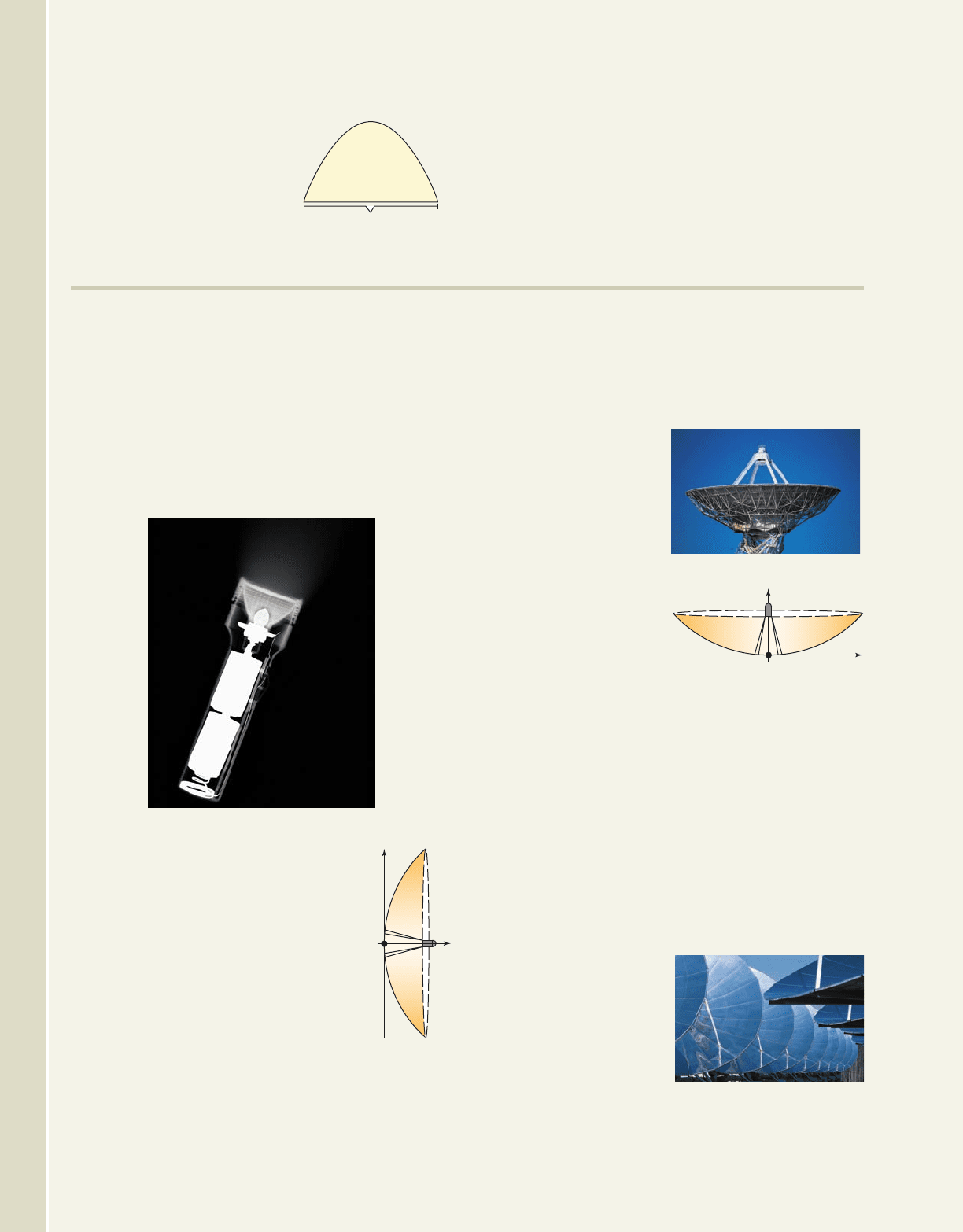
962 CHAPTER 10 Analytic Geometry and the Conic Sections 10-44
College Algebra & Trignometry—
length of the arc ABC
shown, we use the
formula given where a is
the maximum height
attained by the projectile,
b is the horizontal
distance it traveled, and
a
b
B
A
C
“ln” represents the natural log function. Suppose
a baseball thrown from centerfield reaches a
maximum height of 20 ft and traverses an arc
length of 340 ft. Will the ball reach the catcher
310 ft away without bouncing?
APPLICATIONS
85. Parabolic car headlights: The cross section of a
typical car headlight can be modeled by an
equation similar to where x and y are
in inches and . Use this information to
graph the relation for the indicated domain.
86. Parabolic flashlights: The cross section of a
typical flashlight reflector can be modeled by an
equation similar to where x and y are in
centimeters and . Use this information
to graph the relation for the indicated domain.
87. Parabolic sound receivers: Sound
technicians at professional sports
events often use parabolic receivers
as they move along the sidelines.
If a two-dimensional cross section
of the receiver is modeled by the
equation and is 36 in. in
diameter, how deep is the parabolic
receiver? What is the location of
the focus? [Hint: Graph the
parabola on the coordinate grid
(scale the axes).]
88. Parabolic sound receivers: Private investigators
will often use a smaller and less expensive
y
2
54x,
x 30, 2.254
4x y
2
,
x 30, 44
25x 16y
2
,
parabolic receiver (see Exercise 87) to gather
information for their clients. If a two-dimensional
cross section of the receiver is modeled by the
equation and the receiver is 12 in. in
diameter, how deep is the parabolic dish? What is
the location of the focus?
89. Parabolic radio
wave receivers: The
program known as
S.E.T.I. (Search for
Extra-Terrestrial
Intelligence)
identifies a group
of scientists using
radio telescopes to
look for radio
signals from
possible intelligent
species in outer
space. The radio telescopes are actually parabolic
dishes that vary in size from a few feet to hundreds
of feet in diameter. If a particular radio telescope is
100 ft in diameter and has a cross section modeled
by the equation how deep is the
parabolic dish? What is the location of the focus?
[Hint: Graph the parabola on the coordinate grid
(scale the axes).]
90. Solar furnace: Another form of technology that
uses a parabolic dish is called a solar furnace. In
general, the rays of the Sun are reflected by the
dish and concentrated at the focus, producing
extremely high temperatures. Suppose the dish of
one of these parabolic reflectors had a 30-ft
diameter and a cross
section modeled by
the equation
. How deep
is the parabolic dish?
What is the location
of the focus?
x
2
50y
x
2
167y,
y
2
24x,
x
y
Exercise 87
y
x
cob19529_ch10_0954-0965.qxd 12/6/08 12:46 AM Page 962 epg HD 049 :Desktop Folder:Satya 05/12/08:
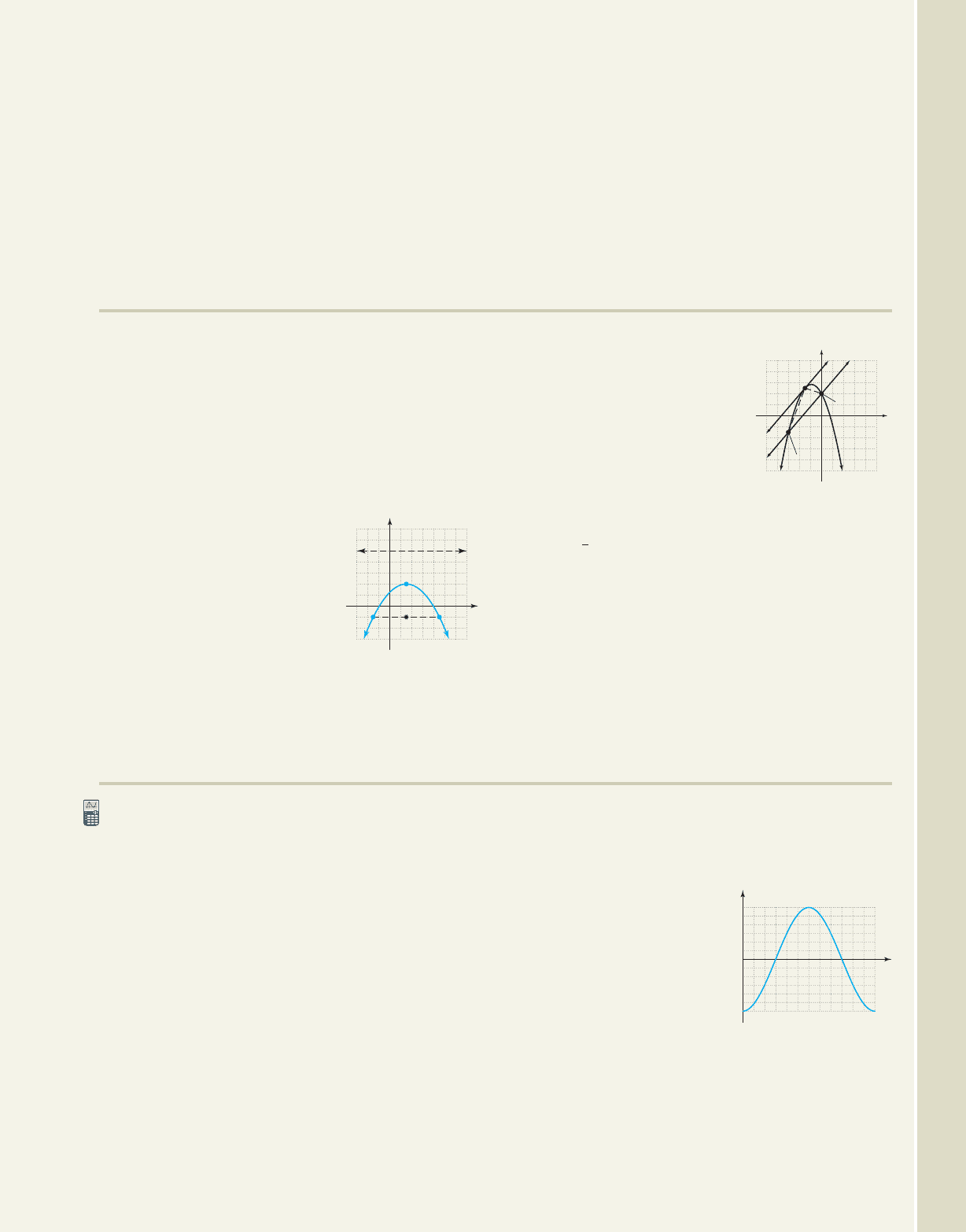
10-45 Section 10.4 The Analytic Parabola 963
College Algebra & Trignometry—
EXTENDING THE CONCEPT
93. In a study of quadratic graphs from the equation
, no mention is made of a
parabola’s focus and directrix. Generally, when
the focus of a parabola is very near its
vertex. Complete the square of the function
and write the result in the form
. What is the value of p?
What are the coordinates of the vertex?
94. Like the ellipse and
hyperbola, the focal chord
of a parabola (also called
the latus rectum) can be
used to help sketch its
graph. From our earlier
work, we know the
endpoints of the focal
chord are 2p units from
the focus. Write the equation
in the form
, and use the endpoints of the
focal chord to help graph the parabola.
4p1y k2 1x h2
2
12y 15 x
2
6x
1x h2
2
4p1y k2
y 2x
2
8x
a 1,
y ax
2
bx c
95. In Exercise 83, a formula
was given for the area of a
right parabolic segment. The
area of an oblique parabolic
segment (the line segment
cutting the parabola is not
perpendicular to the axis) is
more complex, as it involves
locating the point where a
line parallel to this segment is tangent (touches at
only one point) to the parabola. The formula is
where T represents the area of the triangle
formed by the endpoints of the segment and this
point of tangency. What is the area of the parabolic
segment shown (assuming the lines are parallel)?
See Section 9.1, Exercises 46 and 47 and
Section 9.4, Example 3.
A
4
3
T,
91. The reflector of a large, commercial flashlight
has the shape of a parabolic dish, with a diameter
of 10 cm and a depth of 5 cm. What equation
will the engineers and technicians use for the
manufacture of the dish? How far from the vertex
(the lowest point of the dish) will the bulb be
placed? (Hint: Analyze the information using a
coordinate system.)
92. The reflector of an industrial spotlight has the
shape of a parabolic dish with a diameter of
120 cm. What is the depth of the dish if the correct
placement of the bulb is 11.25 cm above the vertex
(the lowest point of the dish)? What equation will
the engineers and technicians use for the
manufacture of the dish? (Hint: Analyze the
information using a coordinate system.)
Exercise 94
x
y
(0, 4)
(6,
3)
(3,
5)
Exercise 95
MAINTAINING YOUR SKILLS
96. (6.6) Find all real solutions to
(round to the nearest degree).
97. (3.3/3.4) Use the function
to comment and give illustrations of the tools
available for working with polynomials:
(a) synthetic division, (b) rational roots theorem,
(c) the remainder and factor theorems, (d) the test
for and , (e) the upper/lower bounds
property, (f) Descartes’ rule of signs, and (g) roots
of multiplicity (bounces, cuts, alternating intervals).
x 1x 1
f1x2 x
5
2x
4
17x
3
34x
2
18x 36
sec 1.1547
98. (1.6) Find all roots (real and complex) to the
equation (Hint: Begin by factoring
the expression as the difference of two perfect
squares.)
99. (6.5) The graph shown
displays the variation in
daylight from an
average of 12 hours per
day (i.e., the maximum
is 15 hours and the
minimum is 9). Use the
graph to approximate
the number of days in a year there are 10.5 or less
hours of daylight. Answers may vary.
x
6
64 0.
6 8 10 12 1442642
x
1
2
1
2
3
4
5
6
7
y
(3, 2)
y 5
(3, 1) (9, 1)
0
Hours
Da
y
of
y
ear
3
60 120 180 240 360
3
300
cob19529_ch10_0954-0965.qxd 01/14/2009 03:09 PM Page 963 ssen 1 HD 049:Desktop Folder:Satya 14/01/09:Used file:MHDQ092-10:
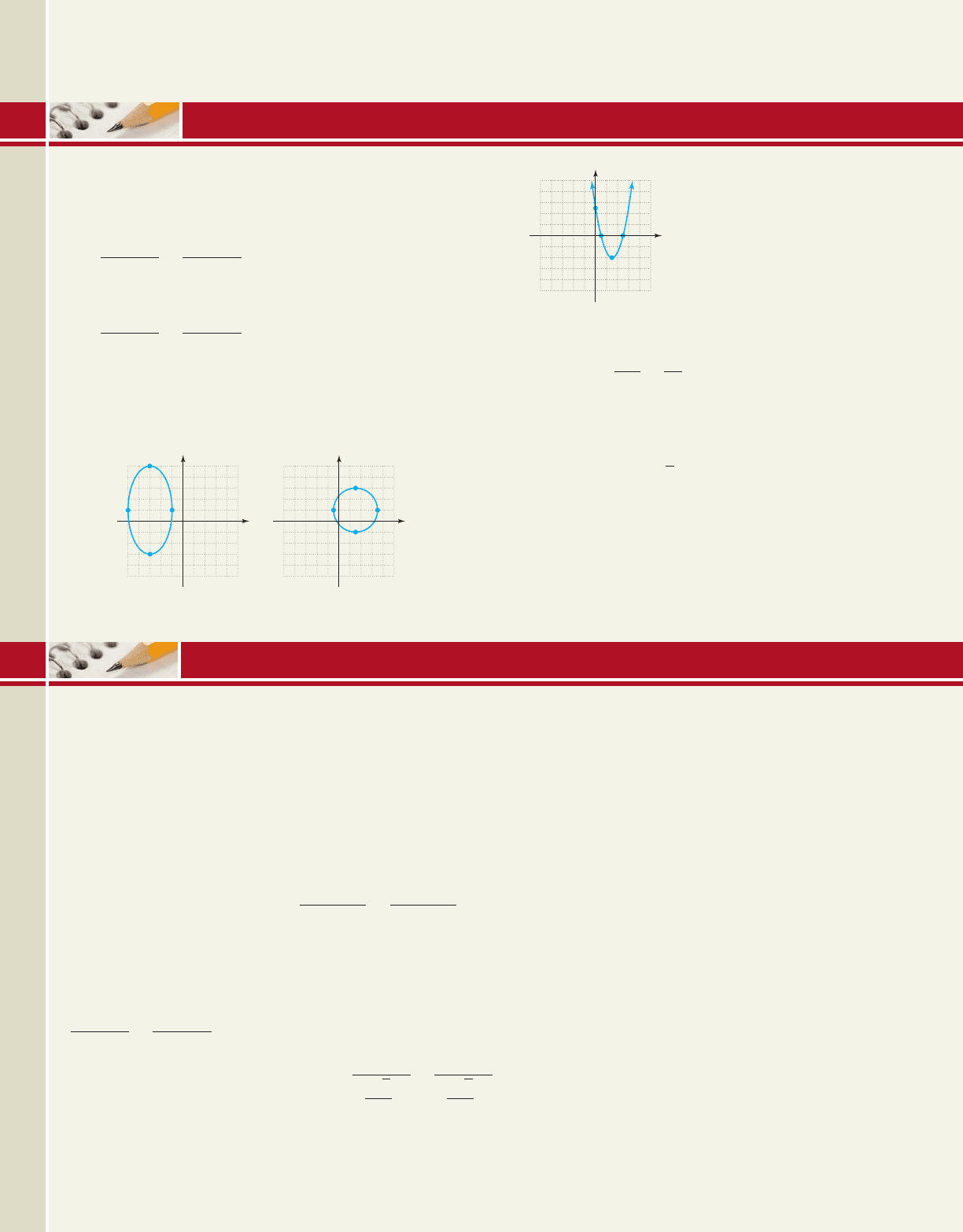
964 CHAPTER 10 Analytic Geometry and the Conic Sections 10-46
College Algebra & Trignometry—
c.
8. Solve the following system of inequalities by
graphing.
9. Find the equation of the ellipse (in standard form) if
the vertices are ( ) and (4, 0) and the distance
between the foci is units.
10. The radio signal emanating from a tall radio tower
spreads evenly in all directions with a range of 50
mi. If the tower is located at coordinates (20, 30) and
my home is at coordinates (10, 78), will I be able to
pick up this station on my home radio? Assume
coordinates are in miles.
413
4, 0
•
x
2
100
y
2
25
1
x
2
1y 42
2
36
8642108642
2
4
6
8
10
4
6
8
2
10
(3, 4)
10
y
x
Sketch the graph of each conic section.
1.
2.
3.
4.
5.
6.
7. Find the equation of each relation and state its
domain and range.
a. b.
8642108642
2
4
6
8
10
4
6
8
2
10
y
(3, 6)
(7, 2)
(3, 2)
(1, 2)
10
x
5432154321
1
2
3
4
5
2
3
4
1
5
y
x
(3, 5)
(3, 3)
(5, 1) (1, 1)
9x
2
4y
2
18x 24y 63 0
1x 32
2
9
1y 42
2
4
1
9x
2
4y
2
18x 24y 9 0
1x 22
2
16
1y 32
2
1
1
x
2
y
2
10x 4y 4 0
1x 42
2
1y 32
2
9
Using the process known as completing the square, we were able to convert from the polynomial form of a conic section
to the standard form. However, for some equations, values of a and b are somewhat difficult to identify, since the coef-
ficients are not factors. Consider the equation the equation of an ellipse.
original equation
subtract 192, begin process
complete the square in x and y
factor and simplify
standard form
Unfortunately, we cannot easily identify the values of a and b, since the coefficients of each binomial square
were not “1.” In these cases, we can write the equation in standard form by using a simple property of fractions—
the numerator and denominator of any fraction can be divided by the same quantity to obtain an equivalent fraction.
Although the result may look odd, it can nevertheless be applied here, giving a result of
. We can now identify a and b by writing these denominators in squared form,
which gives the following expression: The values of a and b are now easily seen as
and Use this idea to complete the following exercises.b 0.745.a 0.866
1x 32
2
a
13
2
b
2
1y 12
2
a
15
3
b
2
1.
1x 32
2
3/4
1y 12
2
5/9
1
41x 32
2
3
91y 12
2
5
1
201x 32
2
271y 12
2
15
201x
2
6x 92 271y
2
2y 12192 27 180
201x
2
6x
____
2 271y
2
2y
____
2192
20x
2
120x 27y
2
54y 192 0
20x
2
120x 27y
2
54y 192 0
Ellipses and Hyperbolas with Rational/Irrational Values of a and b
MID-CHAPTER CHECK
REINFORCING BASIC CONCEPTS
cob19529_ch10_0954-0965.qxd 12/6/08 4:22 AM Page 964 epg HD 049 :Desktop Folder:Satya 05/12/08:
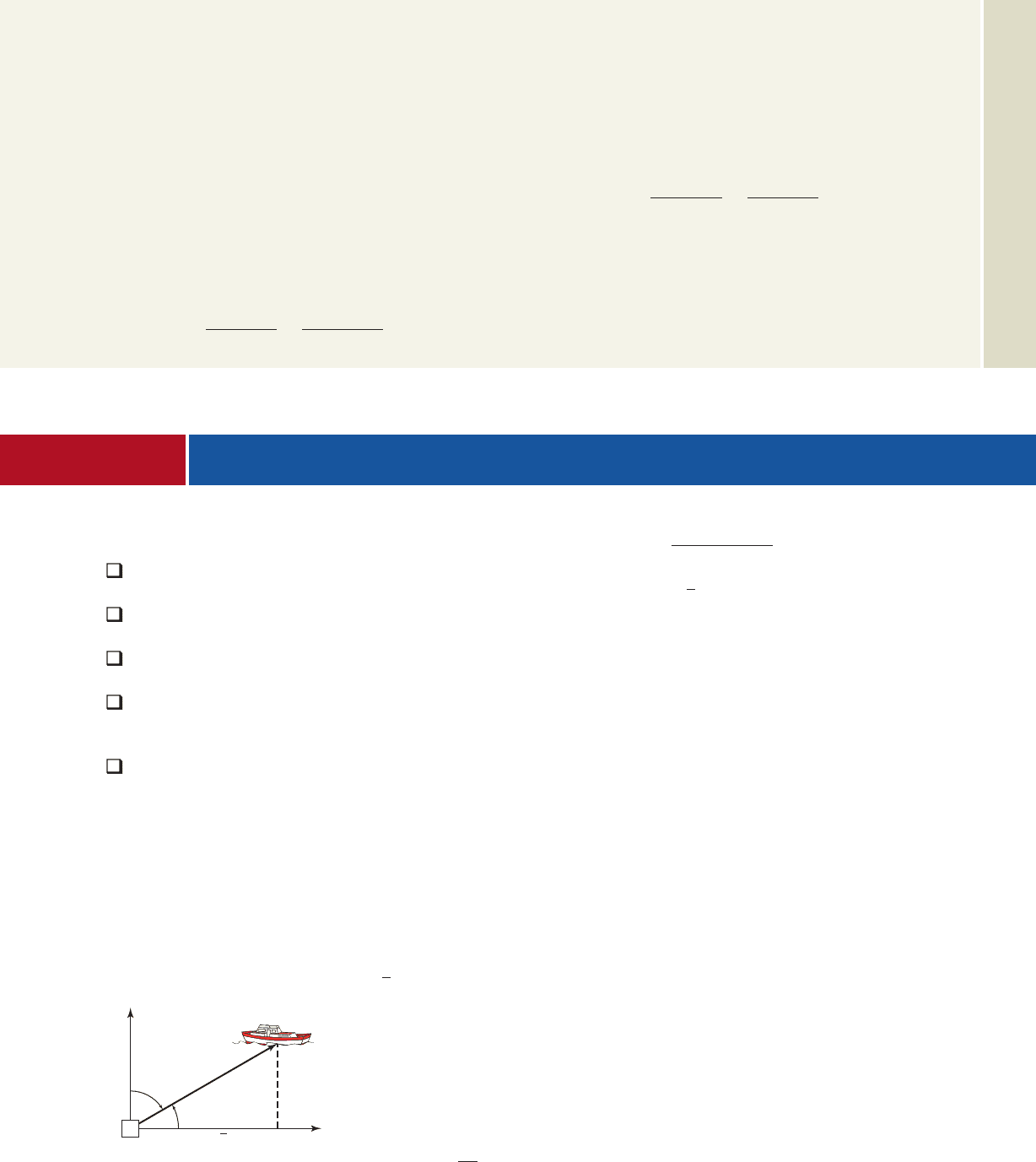
10-47 Section 10.5 Polar Coordinates, Equations, and Graphs 965
College Algebra & Trignometry—
Exercise 1: Identify the values of a and b by writing the
equation in
standard form.
Exercise 2: Identify the values of a and b by writing the
equation in
standard form.
Exercise 3: Write the equation in standard form, then
identify the values of a and b and use them to graph the
ellipse.
41x 32
2
49
251y 12
2
36
1
28x
2
56x 48y
2
192y 195 0
100x
2
400x 18y
2
108y 230 0
Exercise 4: Write the equation in standard form, then
identify the values of a and b and use them to graph the
hyperbola.
91x 32
2
80
41y 12
2
81
1
One of the most enduring goals of mathematics is to express relations with the greatest
possible simplicity and ease of use. For we would
definitely prefer working with although the expressions are equivalent.
Similarly, we would prefer computing in trigonometric form rather than
algebraic form—and would quickly find the result is In just this way, many
equations and graphs are easier to work with in polar form rather than rectangular
form. In rectangular form, a circle of radius 2 centered at (0, 2) has the equation
In polar form, the equation of the same circle is simply
As you’ll see, polar coordinates offer an alternative method for plotting
points and graphing relations.
A. Plotting Points Using Polar Coordinates
Suppose a Coast Guard station receives a distress call from a stranded boat. The boater
could attempt to give the location in rectangular form, but this might require imposing
an arbitrary coordinate grid on an uneven shoreline, using uncertain points of reference.
However, if the radio message said, “We’re stranded 4 miles out, bearing ” the Coast
Guard could immediately locate the boat and send help. In polar coordinates, “4 miles
out, bearing ” would simply be written with r representing the
distance from the station and measured from a horizontal axis in the counter-
clockwise direction as before (see Figure 10.31). If we placed the scenario on a
rectangular grid (assuming a straight shoreline), the coordinates of the boat would be
using basic trigonometry. As you see, the polar coordinate system uses
angles and distances to locate a point in the plane. In this example, the Coast Guard
station would be considered the poleor origin, with the x-axis as the polar axis or axis
of reference (Figure 10.32). A distinctive feature of polar coordinates is that we allow
r to be negative, in which case is the point units from the pole in a direction
opposite to that of (Figure 10.33). For convenience, polar graph paper is often
used when working with polar coordinates. It consists of a series of concentric circles
that share the same center and have integer radii. The standard angles are marked off
in multiples of depending on whether you’re working in radians or degrees
12
15°
1180°2
r
P1r, 2
1213
, 22
7 0
1r, 2 14, 30°2,60°
60°,
r 4 sin .
x
2
1y 22
2
4.
1728.
13 13
i2
6
sin cos ,
tan cot
tan
2
cot
2
sin cos,
Learning Objectives
In Section 10.5 you will learn how to:
A. Plot points given in
polar form
B. Convert from rectangular
form to polar form
C. Convert from polar form
to rectangular form
D. Sketch basic polar
graphs using an r-value
analysis
E. Use symmetry and
families of curves to
write a polar equation
given a polar graph or
information about the
graph
10.5 Polar Coordinates, Equations, and Graphs
Figure 10.31
N
60
30
4 mi
2 mi
shoreline
Coast
Guard
(pole)
2
3 mi
cob19529_ch10_0954-0965.qxd 12/30/08 23:45 Page 965
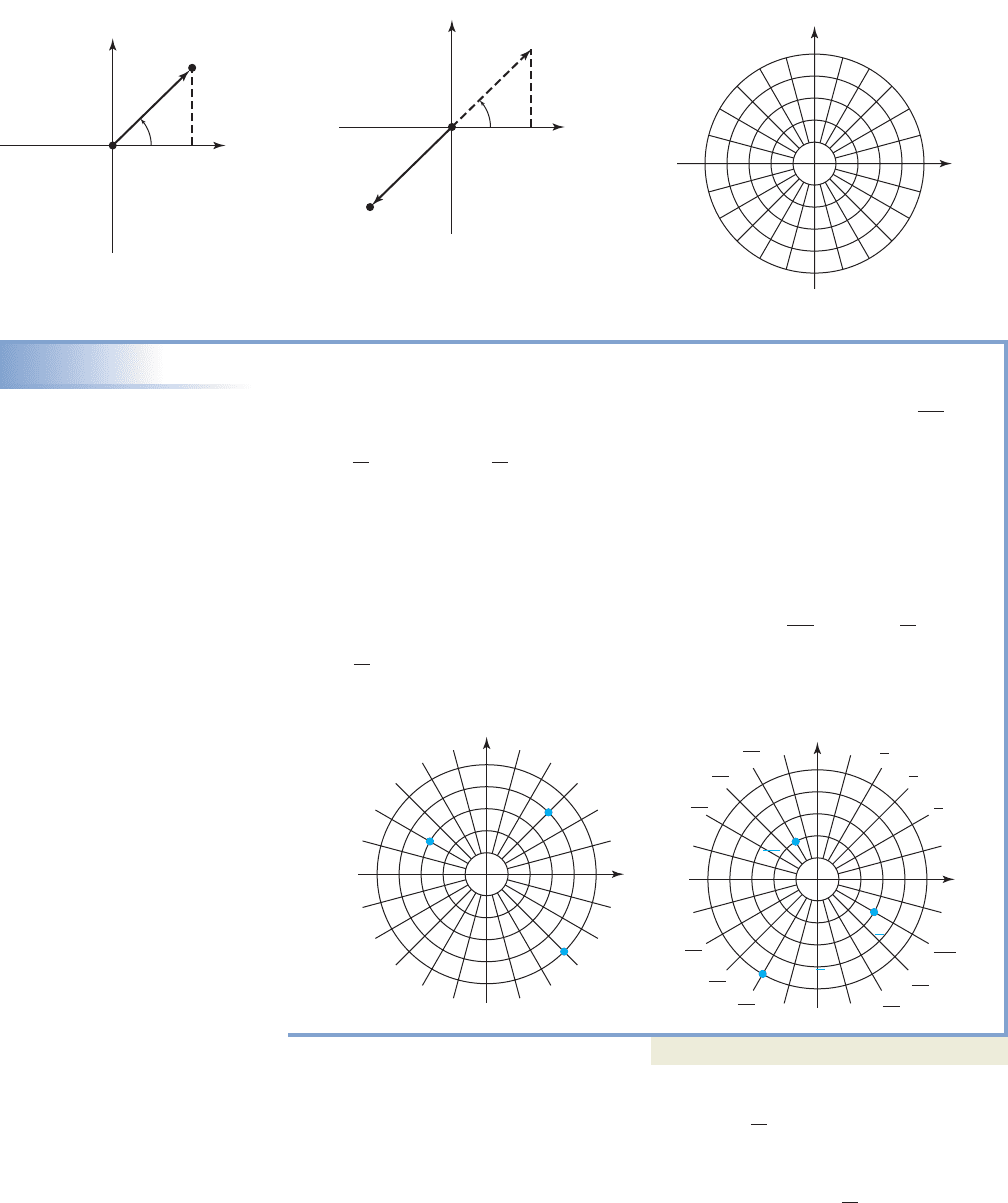
966 CHAPTER 10 Analytic Geometry and the Conic Sections 10-48
(Figure 10.34). To plot the point go a distance of at then move coun-
terclockwise along a circle of radius r. If plot a point at that location (you’re
finished). If the point is plotted on a circle of the same radius, but in the
opposite direction.
EXAMPLE 1
Plotting Points in Polar Coordinates
Plot each point given
and
Solution
For go 4 units at then rotate counterclockwise and plot point A.
For move units at rotate then actually plot point B
in the opposite direction, as shown. Point is plotted by moving
units at rotating then plotting point C in the opposite
direction (since ). See Figure 10.35. The points and
are plotted on the grid in Figure 10.36.Fa3,
6
b
Da2,
2
3
b, Ea5,
3
b,
r 6 0
180°
30°,0°,
3
3
C13, 30°2180°
135°,0°,
5
5B15, 135°2,
45°0°,A14, 45°2
Fa3,
6
b.Ea5,
3
b;
A14, 45°2; B15, 135°2; C13, 30°2; Da2,
2
3
b;P1r, 2
180°r 6 0,
r 7 0,
°0°
r
P1r, 2,
75
2
3
4
5
105
120
135
150
165
195
210
225
240
255 285
Polar graph paper
300
315
330
345
60
45
30
15
1
Polar axis
Pole
P(r, )
r 0
r
Polar axisPole
P(r, )
r 0
r
Figure 10.32
Figure 10.35
Figure 10.36
Figure 10.33
Figure 10.34
2
3
4
5
120
135
150
210
225
240
300
315
330
60
45
30
1
A
(4, 45)
(5, 135)
(3, 30)
C
B
2
3
4
5
3
4
6
2
3
3
4
5
6
7
6
5
4
4
3
5
3
7
4
11
6
1
F
D
E
(
2,
)
2
3
6
(
3,
)
3
(
5,
)
Now try Exercises 7 through 22
While plotting the points and you likely noticed that the
coordinates of a point in polar coordinates are not unique. For it appears
more natural to name the location while for the expression Fa3,
6
b,15, 315°2;
B15, 135°2
Fa3,
6
b,B15, 135°2
College Algebra & Trignometry—
cob19529_ch10_0966-0978.qxd 12/6/08 4:11 AM Page 966 epg HD 049 :Desktop Folder:Satya 05/12/08:

10-49 Section 10.5 Polar Coordinates, Equations, and Graphs 967
is just as reasonable. In fact, for any point in polar coordinates,
and name the same location. See Exercises 23 through 36.
B. Converting from Rectangular Coordinates
to Polar Coordinates
Conversions between rectangular and polar coordi-
nates is a simple application of skills from previous
sections, and closely resembles the conversion from
the rectangular form to the trigonometric form of a
complex number. To make the connection, we first
assume with in Quadrant II (see Figure
10.37). In rectangular form, the coordinates of the
point are simply (x, y), with the lengths of x and y
forming the sides of a right triangle. The distance r from the origin to point P resem-
bles the modulus of a complex number and is computed in the same way:
As long as we have noting is a reference
angle if the terminal side is not in Quadrant I. If needed, refer to Section 5.3 for a review
of reference arcs and reference angles.
Converting from Rectangular to Polar Coordinates
Any point in rectangular coordinates can
be represented as in polar coordinates,
where and
EXAMPLE 2
Converting a Point from Rectangular Form to Polar Form
Convert from rectangular to polar form, with and (round
values to one decimal place as needed).
a. b.
Solution
a. Point is in Quadrant II.
b. Point is in Quadrant IV.
Now try Exercises 37 through 44
P1312, 3122S P16, 315°2
315° 6
r
45° 136
tan
1
a
312
312
b r 313222
2
13222
2
P1312, 3122
P15, 122S P113, 112.6°2
112.6° 13
r
67.4° 1169
tan
1
a
12
5
b r 2152
2
12
2
P15, 122
P1312
, 3122P15, 122
0 360°r 7 0
r
tan
1
a
y
x
b, x 0.r 2x
2
y
2
P1r, 2
P1x, y2
r
r
tan
1
a
y
x
b,x 0,r 2x
2
y
2
.
r 7 0
P1r, 2P1r, 22
P1r, 2a3,
11
6
b
y
y
x
x
r
P
(x, y)
r
Figure 10.37
B. You’ve just learned how
to convert from rectangular
form to polar form
y
y
x
x
r
P(x, y)
r
A. You’ve just learned
how to plot points given in
polar form
College Algebra & Trignometry—
cob19529_ch10_0966-0978.qxd 12/6/08 4:13 AM Page 967 epg HD 049 :Desktop Folder:Satya 05/12/08:
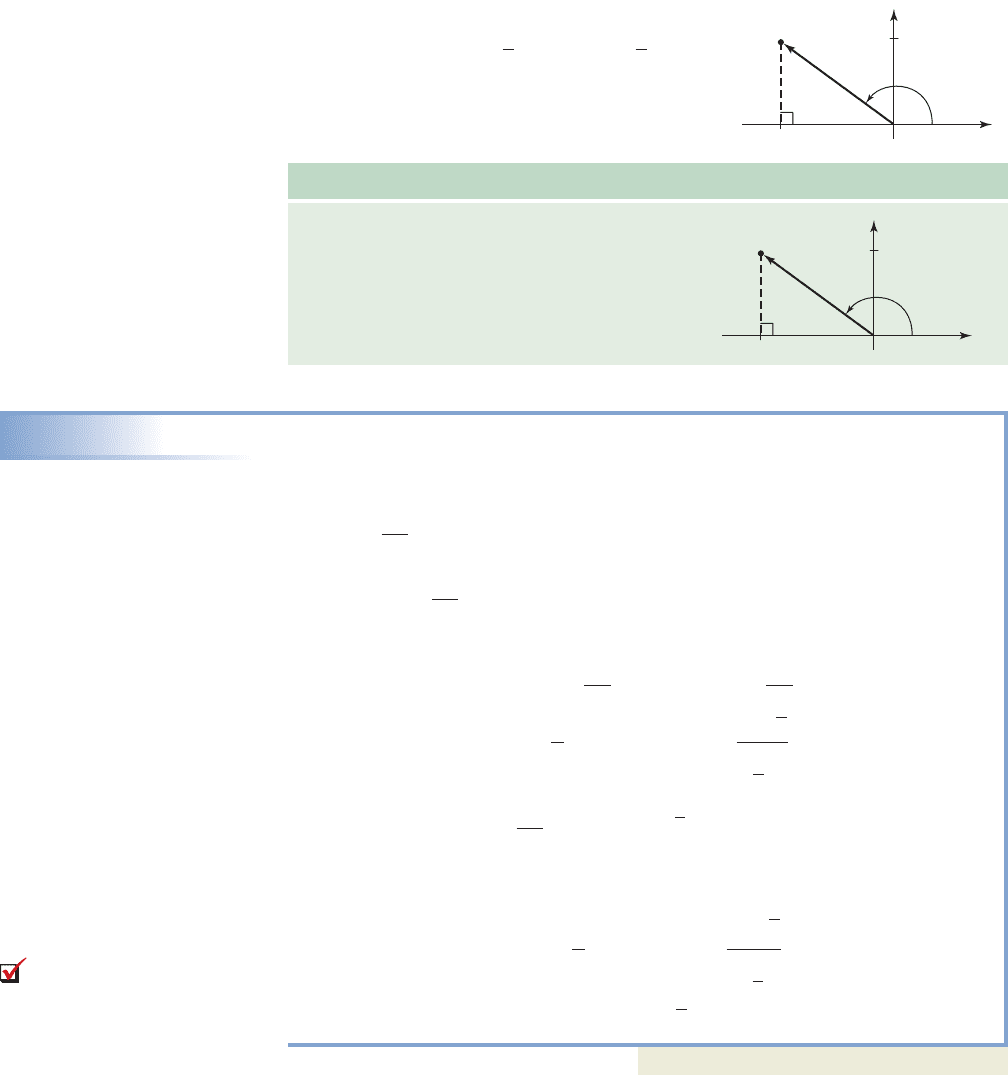
C. Converting from Polar Coordinates to Rectangular
Coordinates
The conversion from polar form to rectangular
form is likewise straightforward. From Figure 10.38
we again note and , giving
and The conversion
simply consists of making these substitutions and
simplifying.
Converting from Polar to Rectangular Coordinates
Any point in polar coordinates can be
represented as P(x, y) in rectangular coordinates,
where and
EXAMPLE 3
Converting a Point from Polar Form to Rectangular Form
Convert from polar to rectangular form (round values to one decimal place as
needed).
a. b.
Solution
a. Point is in Quadrant IV.
b. Point is in Quadrant III.
Now try Exercises 45 through 52
Using the relationships and , we can actually
convert an equation given in polar form, to the equivalent equation in rectangular form.
See Exercises 105 and 106.
x
2
y
2
1x r cos , y r sin ,
P16, 240°2S P13, 313
2 P13, 5.22
313
3
6a
23
2
b 6a
1
2
b
y 6 sin 240° x 6 cos 240°
P16, 240°2
Pa12,
5
3
bS P16, 6132 P16, 10.42
613
6
12a
13
2
b 12a
1
2
b
12 sina
5
3
b 12 cosa
5
3
b
y r sin x r cos
Pa12,
5
3
b
P16, 240°2Pa12,
5
3
b
y r sin .x r cos
P1r, 2
y r sin .x r cos
sin
y
r
cos
x
r
968 CHAPTER 10 Analytic Geometry and the Conic Sections 10-50
y
y
x
x
r
P(x, y)
r
P(r cos , r sin )
y
y
x
x
r
r
C. You’ve just learned how
to convert from polar form to
rectangular form
Figure 10.38
College Algebra & Trignometry—
cob19529_ch10_0966-0978.qxd 12/6/08 12:49 AM Page 968 epg HD 049 :Desktop Folder:Satya 05/12/08:
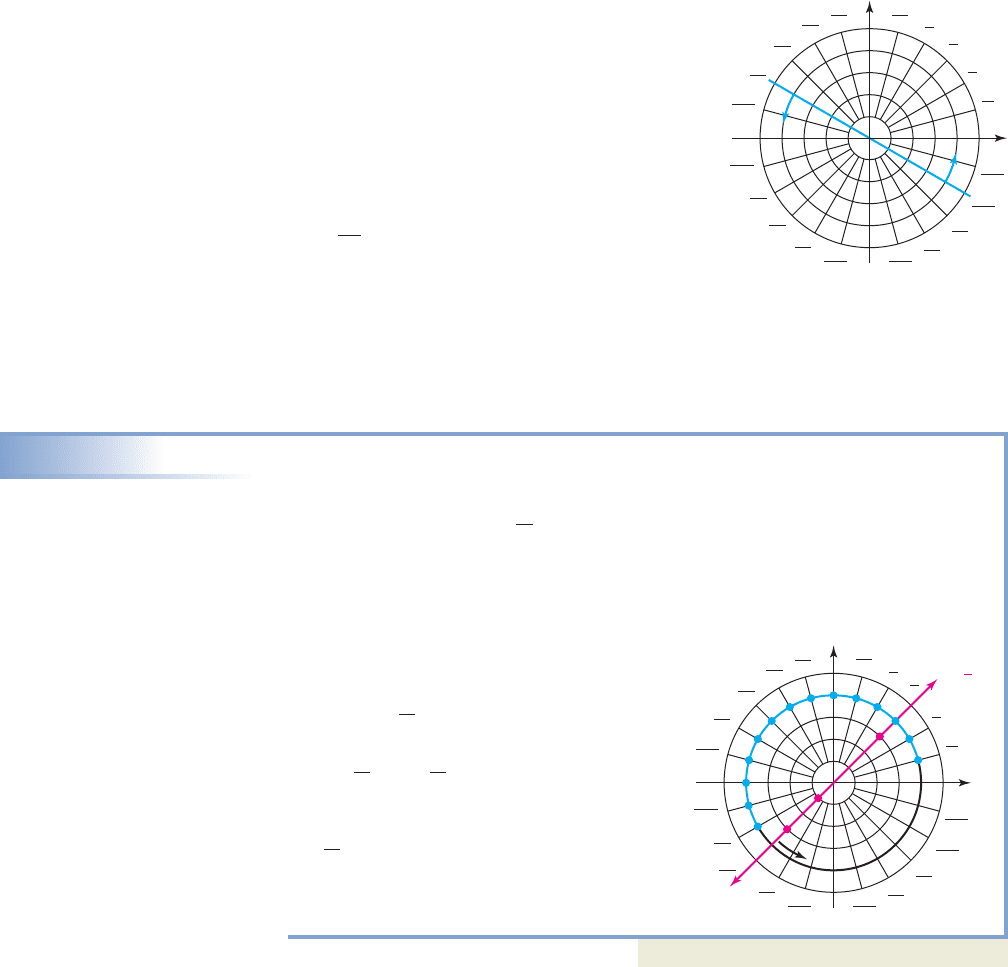
10-51 Section 10.5 Polar Coordinates, Equations, and Graphs 969
College Algebra & Trignometry—
D. Basic Polar Graphs and r-Value Analysis
To really understand polar graphs, an intuitive sense
of how they’re developed is needed. Polar equations
are generally stated in terms of r and trigonometric
functions of with being the input value and r
being the output value. First, it helps to view the
length r as the long second hand of a clock, but
extending an equal distance in both directions from
center (Figure 10.39). This “second hand” ticks
around the face of the clock in the counterclockwise
direction, with the angular measure of each tick
being As each angle “ticks by,”
we locate a point somewhere along the radius,
depending on whether r is positive or negative,
and plot it on the face of the clock before going on to the next tick. For the purposes
of this study, we will allow that all polar graphs are continuous and smooth curves,
without presenting a formal proof.
EXAMPLE 4
Graphing Basic Polar Equations
Graph the polar equations.
a. b.
Solution
a. For we’re plotting all points of the form where r has a constant
value and varies. As the second hand “ticks around the polar grid,” we plot
all points a distance of 4 units from the
pole. As you might imagine, the graph is
a circle with radius 4.
b. For all points have the form
with constant and r varying. In
this case, the “second hand” is frozen at
and we plot any selection of r-values,
producing the straight line shown in the
figure.
Now try Exercises 53 through 56
To develop an “intuitive sense” that allows for the efficient graphing of more
sophisticated equations, we use a technique called r-value analysis. This technique
basically takes advantage of the predictable patterns in and taken
from their graphs, including the zeros and maximum/minimum values.
We begin with the r-value analysis for using the graph shown in
Figure 10.40. Note the analysis occurs in the four colored parts corresponding to
Quadrants I, II, III, and IV, and that the maximum value of
sin
1.
r sin ,
r cos r sin
4
,
4
ar,
4
b
4
,
14, 2r 4,
4
r 4
12
radians 15°.
,
2
3
4
5
3
4
6
12
7
4
5
3
4
3
5
4
7
6
5
6
3
4
2
3
23
12
5
12
7
12
19
12
17
12
13
12
11
12
11
6
1
Figure 10.39
etc.
(
r,
)
4
2
3
5
3
4
6
12
7
4
5
3
4
3
5
4
7
6
5
6
3
4
2
3
23
12
5
12
7
12
19
12
17
12
13
12
11
12
11
6
1
4
cob19529_ch10_0966-0978.qxd 12/6/08 12:49 AM Page 969 epg HD 049 :Desktop Folder:Satya 05/12/08:
